Equipment: Magnifiers and scalpels
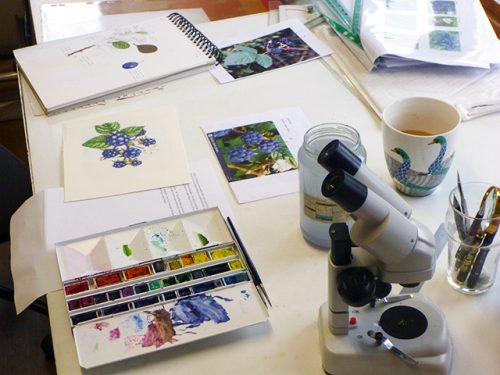
In Equipment: Magnifiers and scalpels, I won’t only be looking at these two bits of kit. It’s a quick overview of all the bits and pieces I use to look at and dissect flowers, plants, and animals. It’s one of a series of blogs on equipment which cover watercolour paints, hotpress watercolour paper, waterproof inks, pencils and erasers, and what paintbrushes to use. As mentioned in the other blogs, a lot of this is down to personal choice, and what you like to use, so it’s neither a proscriptive nor exhaustive list.

Plant clamp
These clamps are really helpful. They clamp to your desk, and the other clamp holds onto whatever specimens you’re drawing, at whatever angle you choose. They can hold direct to a stem, of to a small test-tube with water in that hold the plant. They’re also useful if you ever want to film yourself at work.
Get a decent light
The older I get, the mrore important this has become. I now have a really good daylight LED lamp. It’s adjustable, and the light can be rotated. This means you can get the light on your subject swiftly and easily. Mine is a Daylight Lumi Task lamp. Not cheap, but invaluable.
Scalpels and cutting mats
When you’re illustrating plants, it’s really important to take them apart to see how they work. This helps you understand the different structures, and how all the flower parts fit together. It can also help when you’re looking at fruits and seeds. Cross sections of flowers and fruit are often a requirement with a botanically accurate illustration, so it’s good to have the right kit available.
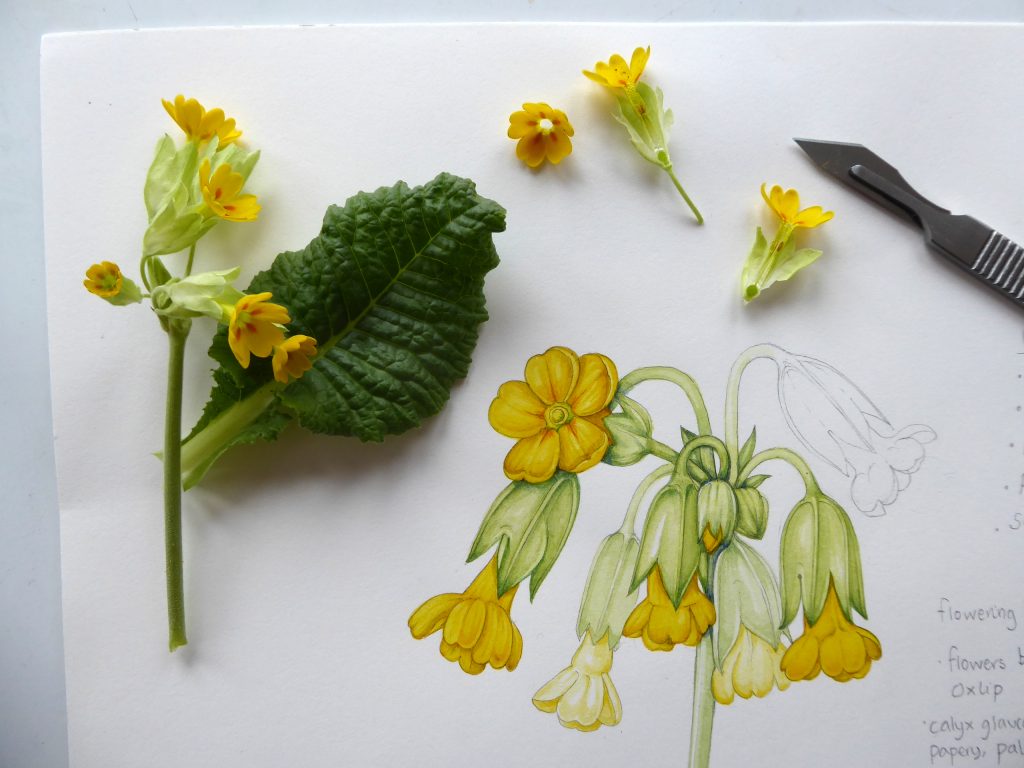
Cowslip Primula veris with dissected flowers, specimen, and scalpel
Scalpels are crucial, along with a good cutting mat. I tend to use “self-healing” cutting mats, which close up after being sliced. These are mostly blue or green, so when I’m busy dissecting I pop a sheet of white printer paper on top so I can see what I’m doing. RS make a good range of these mats.
Scalpels come in many shapes and sizes. I have my posh scalpel, a Swordfish with a number 3 handle. Then my normal everyday Swann-Morton scalpel with replaceable blades. The blades I favour are size 10A. These fit both scalpel handles. I also have lots of craft knives scattered across the studio, and these sometimes get used to help in dissections, or to sharpen pencils.
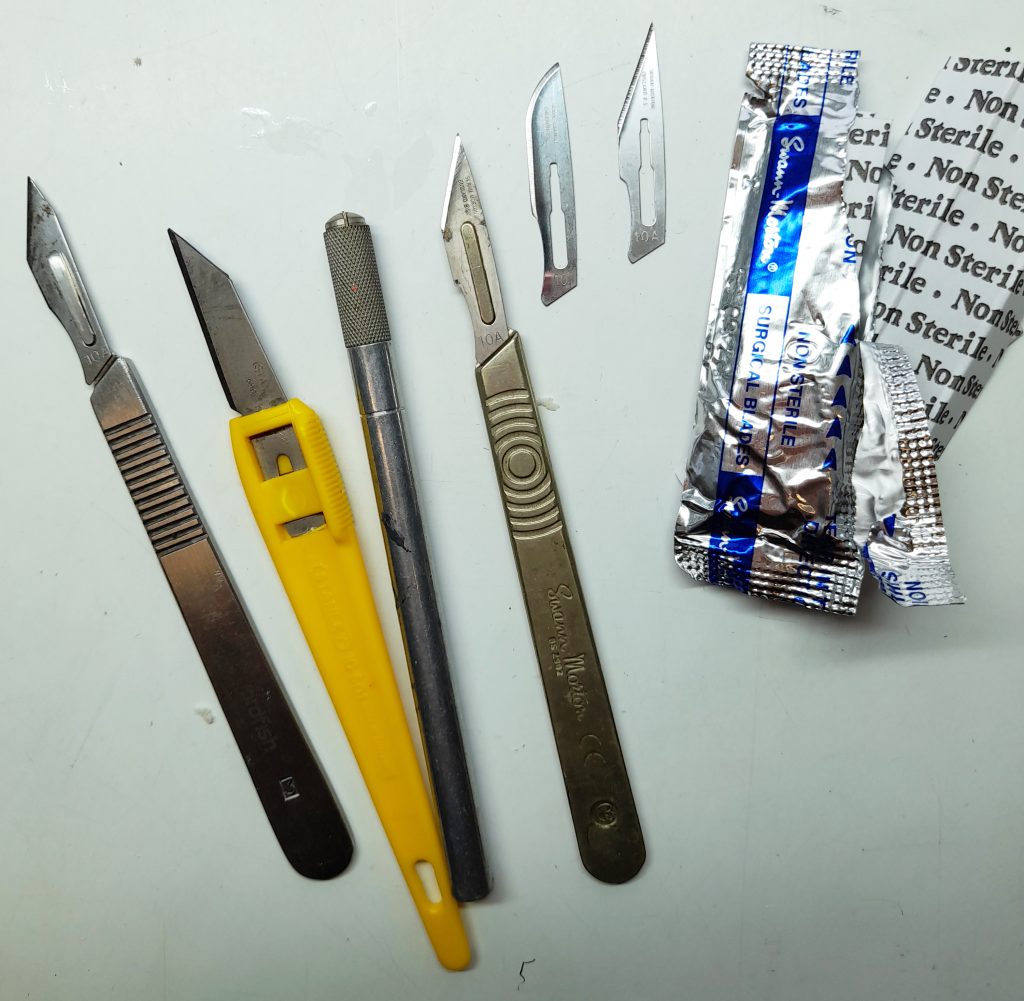
Scalpels: Swordfish, craft knife, Swann-Morton ACM round handle, Swann-Morton handle no.3, curved blade 20, 10A scalpel blades
It’s a good idea to keep your dissecting scalpels just for dissection. Blades blunt incredibly quickly. It’s also worth noting that if you’re trying to cut a section across a leaf or flower, to look at under the microscope, a razor blade is your best bet. DOuble sided ones are the sharpest, and it goes without saying that a great deal of care is needed both when using and when safely storing these. Wilkinson sword make good ones.
Pins and Prodders
I’m pretty sure “prodder” is not a technical term, but I use it to describe a rear-mounted needed with a wooden handle. This tool is properly known as a “seeker” (I think) and is invaluable. I use it all the time to life the edges of leaves, to move things under the microscope, to hold a bit of a plant in place as I draw it. A variant on the theme is the dissecting or prepping needle, another useful and similar tool. I’m sure you can buy these prodders separately, but you may as well invest in a dissection kit. That way you get seekers, scalpels, scissors and forceps all in one handy canvas container. I like the ones sold by NHBS.

Assortment of tools you might find in a dissection kit. The prodder is at bottom left.
I use a lot of pins and foam or polystyrene. This allows me to pin specimens into the correct position when I draw them. I’ve pinned bat and swallow wings, dragonfly bodies, and leaves that seemed intent of curling up. You could invest in entomological pins. These are very slender, so can be used for pinning insects too. They’re also good to use as “prodders” as they have even finer tips than the wooden handled one.
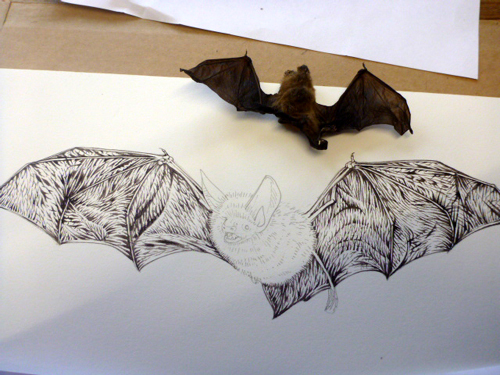
This bat has its right wing pinned into position with an entomological pin
As well as pins, specimens (especially botanical ones) can be held in place with a bit of blu-tak.
Scissors
A fine pair of sharp scissors is great if you want to neatly remove a part of the flower or plant for a closer look. Dissecting scissors are good, as are embroidery scissors which often have tiny blades and sharp pints, Do not use these for anything other than your dissections! They’ll blunt super fast.
Tweezers
You’ll also need a pair of watchmaker’s forceps. These have pointed tips, and are an integral part of a dissection kit. You can sharpen these if needs be on a whetstone.
Measuring
You need a ruler when you’re doing botanical illustration, You may not be working to scale, and that’s fine, but having a good tool at hand which allows you to compare the lengths of different parts of a plant is vital. Your eyes can really trick you, especially when it comes to under-estimating the length of a stem. I have a whole range of lovely Rabone rulers. The longer ones are great to tear paper against, and as cutting edges. Because they’re made from steel, they don’t get nicked or warp like wooden rulers might.
I also use callipers when I’m illustrating insects, it really helps get the proportions correct. Mine are made by Clarke precision.
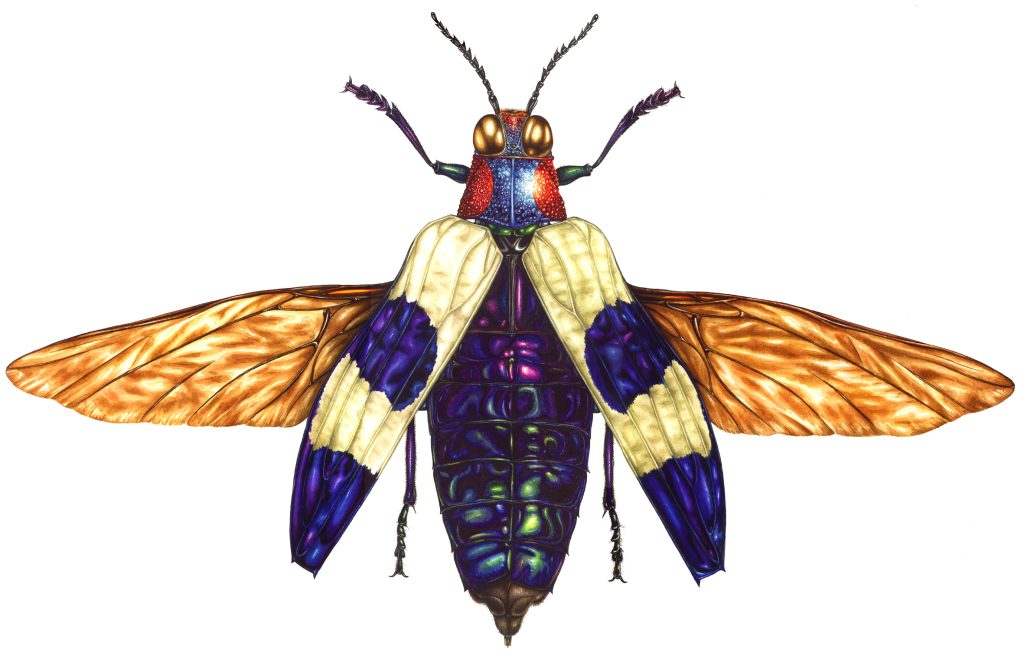
Banded jewel beetle Chrysochroa buqueti rugicollis. This beetle was drawn from a specimen using callipers.
Some illustrators like Proportional dividers, however I’ve never used them. Others use the cunning trick of placing their specimen on graph paper, so you can easily get the sizes right with minimal disturbance.
Magnifying glasses
These are absolutely vital. If you’re trying to identify specimens in the field, or if you’re getting a closer look at a plant you’re drawing, you’ll be needing magnification.
Hand lenses (also known as loupes) are great, and relatively inexpensive. I have several. In the studio, in coat pockets, in my handbag. The same is true of scalpels, although it’s really important to remember that carrying any blade is technically illegal. Not so for the hand lens. These can be hooked onto a finger, or worn around the neck. They tend to multiply x10, x15, or x20. I use mine ALL the time.
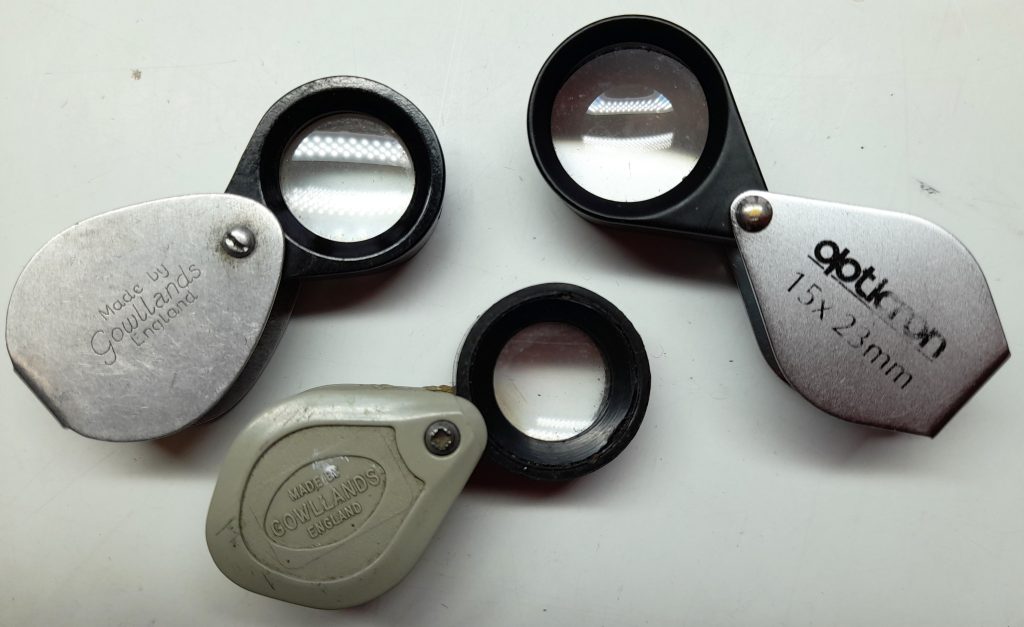
A few of my trusty hand lenses. The one on the left belonged to my father when he studied Zoology at college
They’re made by various companies; Opticron, Kite, and Gowllands. All are good.

Jackdaw Corvus monedula with painting materials…and a hand lens
I have used a desk magnifier, but this broke. For a while I used the glass lens, but eventually this too broke, or perhaps it was stolen by the children for some paper-burning excersizes. Anyway, I know it’s no longer around.
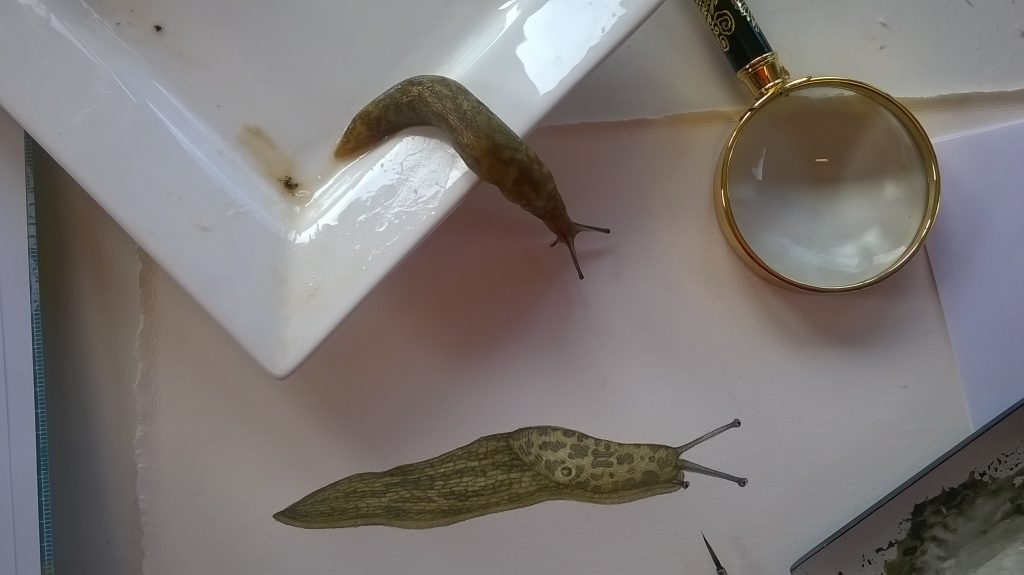
Green cellar slug Limacus maculatus with my illustration and my old hand-held magnifier
I replaced it with a rather good hand-held magnifier. Eventually this was replaced…with glasses! Now I have decent reading glasses and a good daylight lamp, I can see much clearer.
Microscopes: Dissecting microscope
There comes a time in a botanical illustrator’s life when you just have to bite the bullet and buy a dissecting microscope. I use mine a lot. It’s crucial when looking at tiny things like mosses or the flowers of grass. There’s a big enough space under the lens to see plenty, and the magnification is enough to make a real difference to the level of detail. I got mine second hand, which really pushed the price down. A new one from a decent company like Brunel comes in at about £60 – £100. You can even buy additional eye pieces to double the magnification.
If you do invest, buy one which has a battery-operated in-built light source.
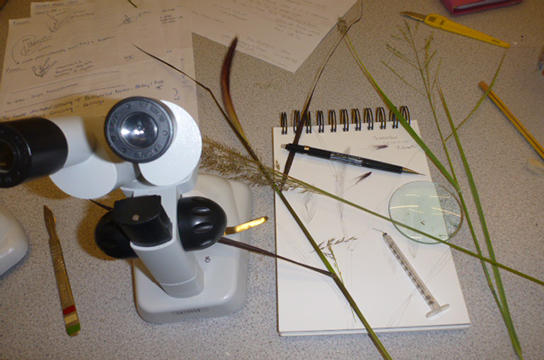
Dissection microscope in use, along with that old broken lens and my sketchbook
Even flowers you initially think are straight forward can reveal secrets when you get them under the dissecting microscope. Sorting out the fold of the calyx of a thrift flower was a case in point. I thought I knew exactly what I was drawing, and then when I double-checked under the microscope it turned out I’d invented bits of the flower! I rely on my microscope to stop mistakes like this before I get caught out by a client…
When working on the Dewberry stamp for Jersey Post, it was so helpful, allowing me to look really closely at the different undeveloped drupelets of a non-ripened berry, and to figure out the thorn shape.

Microscope in use with the Dewberry stamp
Microscopes: Compound microscope
I also have and use a compound microscope which magnifies up to 200x. This is good for really intricate details, and when I’m illustrating micro-organisms. It’s left over from my Zoology degree. I don’t think I would have purchased one for illustration. Unless you’re about to start drawing diatoms, rotifers, and tardigrades I think you should be ok without one of these. Saying that, they are a fascinating insight into the surprising details of the natural world.
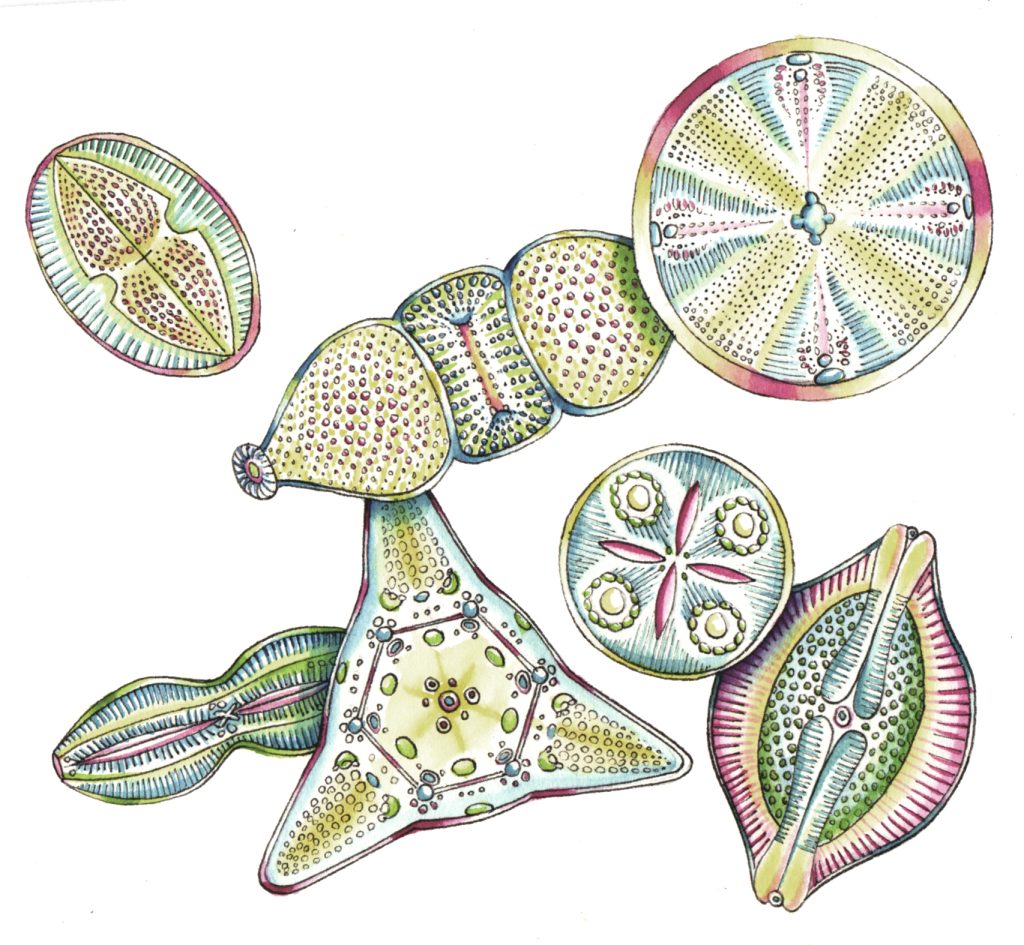
Diatoms seen through the compound microscope
Microscopes: Digital microscope
A friend has just lent me her digital microscope as I’m currently busy illustrating ants. One of the species is only 2mm long, so the microscope helps. I’ve not got used to using it yet, though. I keep worrying about where the eye-pieces are…

My microscopes: Clockwise are the Digital, Compound, and dissecting microscopes
Other useful things
Photos are helpful for reference, and most phones now come with decent ones. Make sure you can take close-up shots though. If you can’t you can buy adapters to help with this. Mine is a Victising 3-in-1 camera lens.
Microscope slides are useful and cheap. You can put a piece of sellotape (sticky side up) onto the slide, then have an immobile and perfectly positioned specimen to draw.
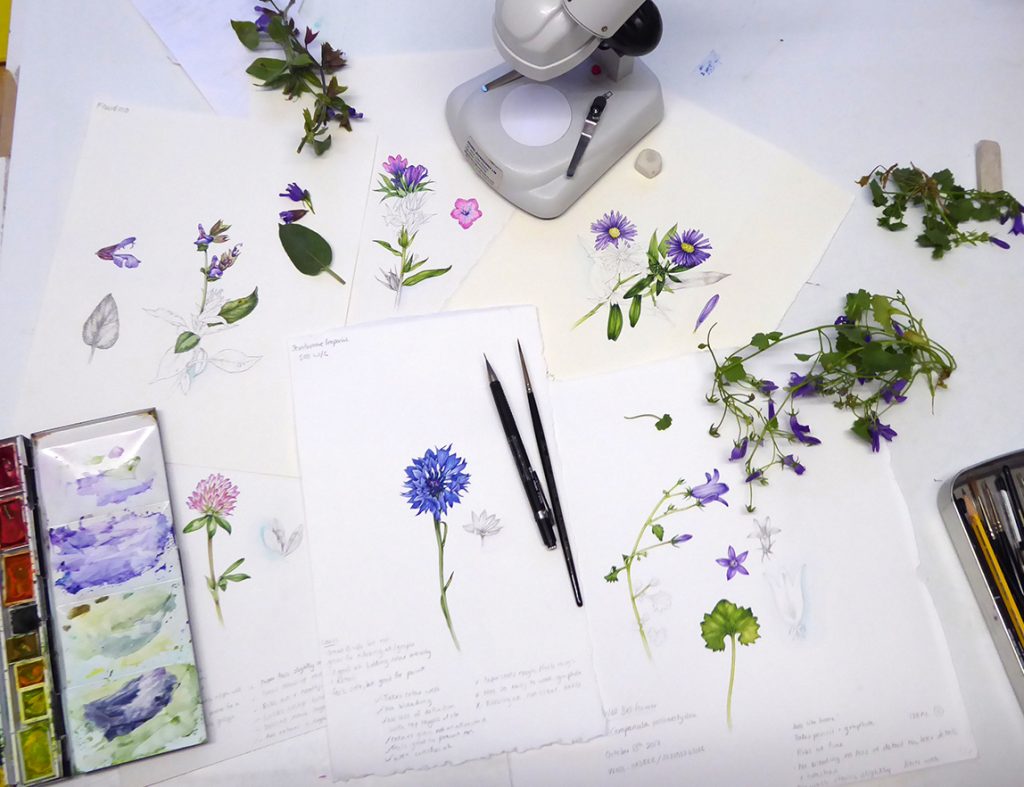
Lots of work and drawing equipment on the desk
Conclusion
A lot of the science-based equipment is pretty obvious. Only a few items cost more than a few pounds (like the microscope) and even these can be found for lower prices second-hand. It’s not to much a list of what you need, as a list of things that will simplify your illustrating life, and make life easier for you.
If you have any beloved bits of kit I’ve not mentioned, f4eel free to share it in the comments box. I’m sure I’m missing all sorts of helpful hints and tricks of the trade – let’s share what we know!


It takes money to be an artist, especially as we age. I used to dig through our burn pile for bits of charcoal to sketch on brown paper bags. I was fifteen and desperate. My watercolor brushes left bits of hair or whatever the cheap bristles were made of. An artist will use whatever is at hand when the urge to create rules. I miss those days.
I enjoy looking at your marvels. You inspire.
Hiya Bobbie, oh I know. Its a real luxury to be able to waltz into my local art supply store and buy whatever I want. And to source plants out of season as cut flowers, or in garden centres. you’re so right. We ARE spoilt, and having the sort of experiences you had when you were younger allows you to appreciate it; something that not everyone can relate to. Thanks for the comment, it’s a lovely and important point that you make. x
Optimizing precision in botanical illustration requires top-notch tools. Consider incorporating Shaft Laser Alignment Equipment for unparalleled accuracy in your creative process. At Bearing Online Store, the UK’s leading Online Bearings & Transmission Shop, we offer a range of precision engineering tools, ensuring your equipment runs at peak performance. Explore our selection to enhance your artistic journey and experience the difference that quality tools can make. Elevate your precision with Bearings Online Store.
Visit : https://www.bearings-online.co.uk/item/3277/SKF/TKBA40-SKF-Belt-Alignment-Tool.html